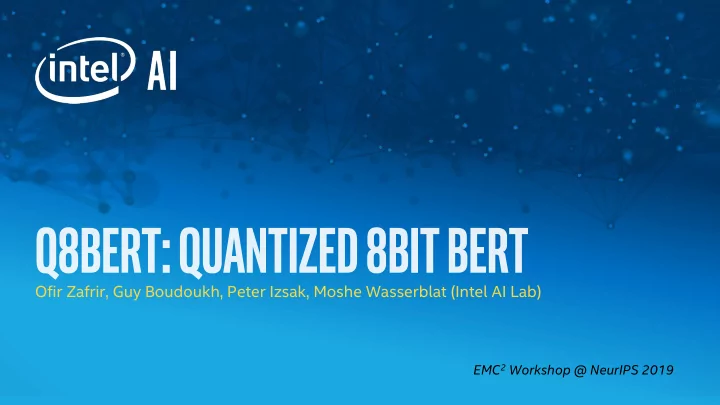

Ofir Zafrir, Guy Boudoukh, Peter Izsak, Moshe Wasserblat (Intel AI Lab) EMC 2 Workshop @ NeurIPS 2019
Motivation • Pre-trained Transformer language models such as BERT, have demonstrated State-of-the-Art results for a variety of NLP tasks • BERT poses a challenge to deployment in production environments Google: “Some of the models we can build with BERT are so complex that • they push the limits of what we can do using traditional hardware”* • Hardware supporting 8bit Integer quantization is emerging • Quantization to 8bit Integers can accelerate inference using only 25% of the memory footprint This Photo by Unknown Author is licensed under CC BY-SA-NC * https://www.blog.google/products/search/search-language-understanding-bert/ 2
Quantization-Aware Training Graph Training (QAT) a e uanti ation • Train Neural Networks (NN) to be Bias quantized at the inference stage GE Inference Graph • Fake quantization is used to a e uanti ation a e uanti ation eights introduce the quantization error training nt Re e uanti e • We apply Fake Quantization on all nt nt Bias GEMM & Word/Position Embedding nt layers GE • Sensitive operations are kept in nt nt FP32 (Softmax, LN, GELU) uanti e eights 3
Experiments & Results • GLUE benchmark and SQuADv1.1 Baseline Our 8bit BERT Relative Task Metric Score (STD) Score (STD) Error Datasets CoLA MCC 58.48 (1.54) 58.48 (1.32) 0.00% • QAT while Fine-tune pre-trained MRPC F1 90 .00 (0.23) 89.56 (0.18) -0.49% MRPC- L* F1 90.86 (0.55) 90.90 (0.29) BERT-Base/Large 0.04% QNLI Acc. 90.30 (0.44) 90.62 (0.29) 0.35% • Reported Mean and STD over five QNLI- L* Acc. 91.66 (0.15) 91.74 (0.36) 0.09% experiments QQP F1 87.84 (0.19) 87.96 (0.35) 0.14% RTE Acc. 69.70 (1.50) 68.78 (3.52) -1.32% • Relative error induced by SST-2 Acc. 92.36 (0.59) 92.24 (0.27) -0.13% quantization is less than 1% STS-B PCC 89.62 (0.31) 89.04 (0.17) -0.65% STS-B- L* PCC 90.34 (0.21) 90.12 (0.13) -0.24% SQuADv1.1 F1 88.46 (0.15) 87.74 (0.15) -0.81% * - L means BERT-Large was used 4
Comparison with Dynamic Quantization • Compare QAT to post training Baseline DQ 8bit BERT Relative Task Metric Score (STD) Score (STD) Error quantization CoLA MCC 58.48 (1.54) 56.74 (0.61) -2.98% MRPC F1 90 .00 (0.23) • Dynamic Quantization (DQ) 87.88 (2.03) -2.36% MRPC- L* F1 90.86 (0.55) 88.18 (2.19) -2.95% • Applied DQ on baseline models for QNLI Acc. 90.30 (0.44) 89.34 (0.61) -1.06% each dataset QNLI- L* Acc. 91.66 (0.15) 88.38 (2.22) -3.58% QQP F1 87.84 (0.19) 84.98 (0.97) -3.26% • DQ method produces significantly RTE Acc. 69.70 (1.50) 63.32 (4.58) -9.15% worse results over all tasks SST-2 Acc. 92.36 (0.59) 91.04 (0.43) -1.43% STS-B PCC 89.62 (0.31) 87.66 (0.41) -2.19% STS-B- L* PCC 90.34 (0.21) 83.04 (5.71) -8.08% SQuADv1.1 F1 88.46 (0.15) 80.02 (2.38) -9.54% *- L means BERT-Large was used 5
Conclusions • We have presented a method for quantizing BERT to 8bit for a variety of NLP tasks with minimum loss in accuracy • We compared our Quantization-Aware Training method to a Post-Training Quantization method and shown our method produces significantly better results • Future directions are to run Q8BERT with supporting hardware and apply other compression methods to BERT and combine them. • We made our work available for the community in our open-source library NLP Architect NervanaSystems/nlp-architect 6
Recommend
More recommend